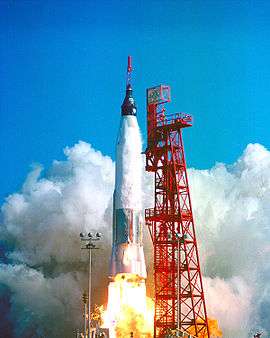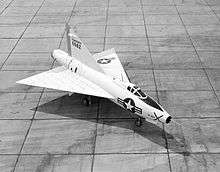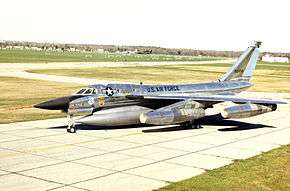Convair
| Industry | Aerospace |
|---|---|
| Fate | Operations shutdown |
| Predecessor |
Consolidated Aircraft Vultee Aircraft |
| Founded | 1943 |
| Defunct | 1996 |
| Headquarters | San Diego, California, United States |
| Products | Aircraft |
| Parent |
General Dynamics (1953–1996) |
_1962.jpg)

Convair was an American aircraft manufacturing company which later expanded into rockets and spacecraft. The company was formed in 1943 by the merger of Consolidated Aircraft and Vultee Aircraft, and went on to produce aircraft such as the Convair B-36 bomber, the F-102 Delta Dagger, the F-106 Delta Dart, the B-58 Hustler bomber plus the Convair 880 and Convair 990 jet airliners. It also manufactured the first Atlas rockets, including the rockets that were used for the manned orbital flights of Project Mercury. The company's subsequent Atlas-Centaur design continued this success and derivatives of the design remain in use as of 2010. In 1994 most of the company's divisions were sold by then-owners General Dynamics to McDonnell Douglas and Lockheed, with the remaining components deactivated in 1996.
Origins
The Consolidated Vultee Aircraft Corporation, whose name was in the course of time changed to Convair, was an American aircraft, rocket, and spacecraft company for the design, development, and manufacturing of aerospace products. It existed as a company from 1943 until 1994, although the Consolidated Aircraft company existed before that, and Consolidated produced important aircraft in the early years of World War II, especially the B-24 Liberator heavy bomber and the PBY Catalina seaplane for the U.S. Navy, the Royal Canadian Air Force, the British flying forces, and others. The Catalina remained in production through May 1945, and more than 4,000 were built. What was soon to be called "Convair" (first unofficially, and then officially), was created in 1943 by the merger of the Consolidated Aircraft Company and the Vultee Aircraft Company. This merger produced a large airplane company, ranked fourth among United States corporations by value of wartime production contracts, higher than the giants like Douglas Aircraft, Boeing, and Lockheed.[1] Convair always had most of its research, design, and manufacturing operations in San Diego County of Southern California, and nearby counties, though other locations were involved as well.
Jet Age, Cold War, and Space Age
In March 1953, all of the Convair company was bought by the General Dynamics Corporation, a conglomerate of military and high-technology companies, and it became officially the Convair Division within General Dynamics.[2]
After the beginning of the Jet Age of military fighters and bombers, Convair was a pioneer of the delta-winged aircraft design, along with the French Dassault aircraft company, which designed and built the Mirage fighter planes.
One of Convair's most famous products was the ten-engined Convair B-36 strategic bomber, burning four turbojets and turning six pusher propellers driven by Pratt & Whitney R-4360 Wasp Major radial piston engines. The Convair B-36 was the largest landbased piston engined bomber in the world. The Atlas missile, the F-102 Delta Dagger and F-106 Delta Dart delta-winged interceptors, and the delta-winged B-58 Hustler supersonic intercontinental nuclear bomber were all Convair products. For a period of time in the 1960s, Convair manufactured its own line of jet commercial airliners, the Convair 880 and Convair 990, but this did not turn out to be a profitable business. However, Convair found that it was profitable to become an aviation subcontractor and to manufacture large subsections of airliners, such as fuselages for the larger airliner companies, McDonnell Douglas, Boeing, and Lockheed. The Convair Division produced its own airplane designs, such as several airliners, until 1965, when it shifted from these to airframe/aerostructure subcontracting projects for other companies.
In the 1950s Convair shifted money and effort into its missile and rocket projects, producing the Terrier missile ship-launched surface-to-air system for the U.S. Navy during the 1960s and 1970s. Convair's Atlas rocket was originally developed in 1957 as an ICBM for the U.S. Air Force. It was replaced in 1962 by the room-temperature liquid-fueled Titan II missile and the solid-fueled Minuteman missile. The Atlas rocket transitioned into a civilian launch vehicle and was used for the first orbital manned U.S. space flights during Project Mercury in 1962 and 1963.
The Atlas rocket became a very reliable booster for launching of satellites and continued to evolve, remaining in use into the 21st century, when combined with the Centaur upper stage to form the Atlas-Centaur rocket for launching geosynchronous communication satellites and space probes. The Centaur rocket was also designed, developed, and produced by Convair, and it was the first widely used outer space rocket to use the all-cryogenic fuel-oxidizer combination of liquid hydrogen and liquid oxygen. The use of this liquid hydrogen – liquid oxygen combination in the Centaur was an important direct precursor to the use of the same fuel-oxidizer combination in the Saturn S-II second stage and the Saturn S-IVB third stage of the gigantic Saturn V moon rocket of the Apollo project. The S-IVB had earlier also been used as the second stage of the smaller Saturn IB rocket, such as the one which was used to launch Apollo 7. The Centaur upper stage was first designed and developed for launching the Surveyor lunar landers, beginning in 1966, to augment the delta-V of the Atlas rockets and give them enough payload capability to deliver the required mass of the Surveyors to the Moon.
More than 100 Convair-produced Atlas-Centaur rockets (including those with their successor designations) were used to successfully launch over 100 satellites, and among their many other outer-space missions, they launched the Pioneer 10 and Pioneer 11 space probes, the first two to be launched on trajectories that carried them out of the Solar System.
In addition to aircraft, missiles and space vehicles, Convair developed the large Charactron vacuum tubes, which were the precursors of modern cathode ray tube (CRT) computer displays,[3] and to give an example of a minor product, the CORDIC algorithms, which is widely used today to calculate trigonometric functions in calculators, field-programmable gate arrays, and other small electronic systems.
Dissolution
In 1994, the General Dynamics Corporation split and sold the original Convair Division, along with other General Dynamics aerospace units that had been swept into it over the decades. The airframe/aerostructures manufacturing company and the space boosters company (both mostly in California) were sold to the McDonnell Douglas Corporation. The Fort Worth, Texas factory and its associated engineering locations and laboratories – which had been previously used for the manufacture of hundreds of General Dynamics F-111 Aardvark fighter-bombers and F-16 Fighting Falcon fighters for the U.S. Air Force, along with dozens of smaller projects – were sold, along with all intellectual property and the legal rights to the products that were being designed and built within, to the Lockheed Corporation. In 1996, General Dynamics deactivated all of the remaining legal entities of the Convair Division.
Timeline
- 1923 Consolidated Aircraft Corporation formed by Major Reuben H. Fleet
- 1934 AVCO acquired the Airplane Development Corporation from Cord and formed the Aviation Manufacturing Corporation (AMC)
- 1936 AMC liquidated to form the Vultee Aircraft Division, an autonomous subsidiary of AVCO
- 1939 Vultee Aircraft Division of AVCO reorganized as an independent company known as Vultee Aircraft, Inc.
- 1941 Consolidated Aircraft Corporation sold to AVCO
- 1943 Consolidated-Vultee, formed by the merger of Consolidated Aircraft and Vultee Aircraft; still controlled by AVCO
- 1947 Convair acquired by the Atlas Corporation
- 1953–1954 Convair acquired by General Dynamics[9][10]
- 1985 General Dynamics formed their "Space Systems Division" from the Convair Space Program
- 1992 Missile Systems Division sold to Hughes Aircraft Company
- 1994 Space Systems Division sold to Martin Marietta (now Lockheed Martin)
- 1994 Convair Aircraft Structures unit sold to McDonnell Douglas (now Boeing)
Products
Aircraft




- Vultee XA-41 (1944) – ground attack aircraft prototype
- Convair XB-53 (1945) – proposed jet-powered medium bomber, project cancelled before prototypes completed
- Consolidated Vultee XP-81 (1945) – escort fighter aircraft
- Convair B-36 Peacemaker (1946) – intercontinental bomber
- Convair NB-36H (1955) – testbed for X-6
- Convair Model 116 (1946) – flying car aircraft
- Stinson 108 (1946) – general aviation aircraft
- Convair Model 110 (1947) – twin engine airliner prototype
- Convair CV-240 (1947)
- Convair CV-300
- Convair CV-340
- Convair CV-440 Metropolitan
- Convair C-131 Samaritan
- Convair T-29
- Convair R4Y Samaritan
- Convair CV-540 (1955)
- Convair CV-580
- Convair CV-600 (1965)
- Convair CV-640
- Convair CV 5800
- Canadair CC-109 Cosmopolitan – licence built turboprop powered CV-440
- Convair CV-240 (1947)
- Convair Model 118 ConvAirCar (1947) – flying car aircraft
- Convair XB-46 (1947) – medium-bomber aircraft
- Convair XC-99 (1947) – heavy transport aircraft
- Convair XF-92 (1948) – experimental delta-winged interceptor aircraft
- Convair R3Y Tradewind (1950) – military flying boat
- Convair X-6 (1951) – proposed nuclear powered aircraft
- Convair YB-60 (1952) – jet bomber prototype based on B-36
- Convair F-102 Delta Dagger (1953) – delta-winged supersonic interceptor aircraft
- Convair F2Y Sea Dart (1953) – seaplane fighter
- Convair XFY Pogo (1954) – experimental VTOL fighter
- Convair XP6Y (1955) – unbuilt ASW flying boat
- Convair B-58 Hustler (1956) – supersonic strategic bomber
- Convair F-106 Delta Dart (1956) – delta-winged supersonic interceptor
- Convair 880 (1959) – jet airliner
- Convair Kingfish (1959) – proposed stealth reconnaissance aircraft, project cancelled
- Convair Model 58-9 (1960s) – proposed supersonic transport aircraft developed from the B-58
- Convair 990 Coronado (1961) – jet airliner
- Convair Model 48 Charger (1964)
- Convair Model 49 (1967-project)
- Convair 660 (1967) – proposed short haul twinjet
Note: U.S. Air Force and U.S. Navy aircraft designations that begin with "X" are merely experimental models of aircraft made only in small numbers. Military aircraft designations that begin with "Y" are developmental models made in small batches, which may or may not have subsequently entered large-scale production.
In the former designation system that the Navy and the Marine Corps used, a final letter of "Y" identified a Convair or a Consolidated product, such as the PBY-5 flying boat.
Missiles and rockets
- RTV-A-2 Hiroc (1946) – high-altitude rocket
- SAM-N-2 Lark (late 1940s) – surface-to-air naval missile
- MX-774 (1948) – precursor to Atlas
- XSM-74 (1950s) – decoy cruise missile
- RIM-2 Terrier (1951) – surface-to-air naval missile
- RIM-24 Tartar (1962) – surface-to-air naval missile
- XGAM-71 Buck Duck (1955) – decoy missile
- Sky Scorcher (1956) – proposed air-to-air missile
- Pye Wacket (1957) – air-to-air defensive missile project, cancelled during development
- FIM-43 Redeye (1960) – man-portable surface-to-air missile
- Atlas (rocket family) (1959) The Atlas civilian space booster
- Atlas E/F
- Atlas G
- Atlas H
- Atlas LV-3B
- Atlas SLV-3
- Atlas-Able
- Atlas-Agena
- SM-65 Atlas – The Atlas ICBM Air Force missile (1957)
- Convair X-11 and SM-65A Atlas (1957) – Atlas A prototype
- Convair X-12 and SM-65B Atlas (1958 – Atlas B prototype
- SM-65C Atlas
- SM-65D Atlas
- SM-65E Atlas
- SM-65F Atlas
- Atlas-Centaur (1962) and its successor-designations, all of which combined an Atlas booster with a centaur upper stage – a civilian rocket to launch spacecraft to outer space.
- Centaur (1962)
- BGM-109 Tomahawk long-range, all-weather, subsonic cruise missile.
- AGM-129 Advanced Cruise Missile (1983) – stealthy, nuclear, air-launched cruise missile
Legacy
"Convair Drive" at the Toronto Pearson International Airport is believed to be named for the Convair company.
References
- ↑ Peck, Merton J. & Scherer, Frederic M. The Weapons Acquisition Process: An Economic Analysis (1962) Harvard Business School p.619
- ↑ "General Dynamics Corporation". U.S. Centennial of Flight Commission. Archived from the original on 2008-11-12. Retrieved 2006-03-31.
- ↑ "Charactron Tube". Computing at Chilton, of Atlas Computer Laboratory, Chilton. 2006-08-05. Retrieved 2006-10-22.
- ↑ Textron Lycoming Turbine Engine, a Company History of AVCO and Lycoming/Textron
- ↑ Avco Financial Services, Inc. from the Lehman Brothers Collection – Twentieth Century Business Archives
- ↑ Consolidated Vultee Aircraft Corporation Archived June 6, 2011, at the Wayback Machine., U.S. Centennial of Flight Commission
- ↑ General Dynamics Corporation Archived November 12, 2008, at the Wayback Machine., U.S. Centennial of Flight Commission
- ↑ Central Manufacturing Co. of Connersville, Indiana, a history of Cord, AVCO, and others
- ↑ "Atlas to sell big block of Convair stock". Pittsburgh Post-Gazette. United Press. March 31, 1953. p. 17.
- ↑ "General Dynamics, Vultee Directors Approve Merger". The Day. New London, CT. March 2, 1954. p. 15.
External links
| Wikimedia Commons has media related to Convair. |


